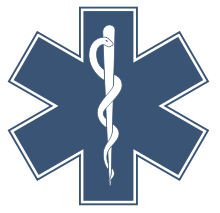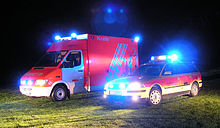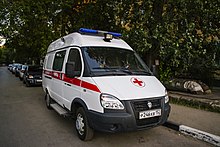Emergency medical services
This is the sighted version that was marked on April 20, 2021. There are 3 pending changes that still need to be sighted.
![]()
This article is about the rescue service in the interior. For other meanings, see Search and rescue service.
The rescue service is the professional preclinical medical assistance for emergency patients. Its task is to provide rapid and appropriate help around the clock in the event of medical emergencies of all kinds - injuries, poisoning and illnesses - by deploying qualified rescue personnel and the appropriate rescue equipment and to save lives or alleviate suffering. A distinction is made between:
- the ground-based rescue service with the tasks of emergency rescue and qualified patient transport
- of air rescue,
- the mountain rescue service,
- of cave rescue,
- and the water rescue,
whereby the special organizations of mountain or water rescue hand over the patient to the general rescue service for further care after the rescue.
The Star of Life has established itself as an international symbol for the rescue service, although in some countries (including Germany and Austria) it is protected under trademark law by individual organisations.
Rescue is the term used to describe the totality of all facilities and measures for saving human lives.

The rescue chain

The "Star of Life"

ambulance and emergency ambulance
History
The first early structural approaches to rescue services can already be found in the Napoleonic era. First of all, people responsible for caring for the wounded had to be found to go into battle with them. Although doctors were established as a profession, armies were not accompanied by physicians. This was not common practice at the time. So one had to rely on others or their skills. Barbers and barbers formed the "rescue service". They were practically the only ones who dealt with human anatomy. During battles they remained at a safe distance. When there were the first wounded, they ran to the battlefield with wooden carts and transported the wounded away. There is no historiographical consensus about the concrete possibilities of care at that time, but the hygienic conditions must have been catastrophic.
Contrary to many a common perception, the officially promoted and nowadays self-evident in the general public consciousness "rescue of people from danger to life" and in medical emergencies was only a phenomenon of the late 18th and early 19th century. At the end of the 18th century, the first official rescue ordinances came into being in the individual German states, in which life-saving was declared to be the duty of every citizen and rewards were offered for successful resuscitations of "apparent dead", and which also contained contemporary instructions for assistance and life-saving.
At the end of the 19th century, most large German cities had an organized ambulance system. Private companies, civilian Samaritan associations, ambulance crews of the German Red Cross (DRK) and/or the fire brigade were charged with carrying out the service. The motorization of patient transport began after the First World War. In the spring of 1943, a National Socialist "Führer decree" attempted to standardize the ambulance service in Germany, which the Nazi government wanted to be assigned exclusively to the German Red Cross. The outcome of the Second World War put an end to this attempt.
After the period of National Socialism and the German Reich, the occupying powers initially transferred the provision of ambulance services and thus also emergency rescue to the municipalities (for example in the British occupation zone) or to the denazified and newly founded German Red Cross. In the 1950s, concessions were increasingly awarded to private companies, especially outside the major cities, to provide ambulance services and, in the absence of other regulations, to provide emergency rescue services.
The increasing density of road traffic led to a steady rise in the number of accidents from around the end of the 1950s. In addition, from the mid-1960s onwards, there were new findings and improved principles in the treatment of emergency patients and the resulting further developments in vehicle and equipment technology. The existing rescue system in Germany was unable to keep pace with these new requirements, and since the 1960s a deplorable "rescue emergency" has developed, also in the perception of the public. From the mid-1960s, this unbearable situation led to increased commitment on the part of administrative experts, medical professionals and aid organisations, and finally to the official reorganisation of the rescue service from the early 1970s onwards. During these years, private initiatives and especially the Björn Steiger Foundation also put a lot of effort into building up the appropriate infrastructure with emergency call points and vehicles. Since these goals have now been achieved, this foundation is committed to combating sudden cardiac death and is trying to distribute layman's defibrillators (AEDs) throughout the country.
See also: History of ambulances

Exercise of the Polish rescue service
Rescue service in Europe
112 has been agreed as the standard emergency number throughout Europe for all types of requests for assistance, which are then forwarded to the appropriate body if necessary. In addition, there are still numerous different nationally and locally valid emergency numbers in Europe.
Europe-wide standards exist, for example, for
- Emergency service clothing (DIN EN 443, DIN EN 471, DIN EN 659)
- Vehicles for patient transport (DIN EN 1789)
- Ambulance stretchers (DIN EN 1865)
Some rescue service organisations are also certified according to European quality management standards (ISO 900x). These organisations thus guarantee to maintain a certain standard, from the procurement of materials to the treatment of the patient.
There are no EU or even Europe-wide guidelines for adherence to certain response times. At most, there is a recommendation for a response time of between ten and twenty minutes, which the member states are free to vary upwards or downwards.

Ambulance with the emblem of the Red Cross in Nizhny Novgorod, Russia

care of an emergency patient
Questions and Answers
Q: What are emergency medical services (EMS)?
A: Emergency medical services (EMS), also known as ambulance services or paramedic services, are agencies that deal with medical emergencies, mostly by sending ambulances to help people who are severely ill or injured.
Q: What is the job of the staff of the ambulances in EMS?
A: The job of the staff of the ambulances in EMS is to treat people at the scene and to take them to a hospital if needed.
Q: How are ambulances staffed in EMS?
A: Some ambulances have staff with more basic training, known as "emergency medical technicians", while others have doctors with advanced training.
Q: How does the role of EMS differ by country?
A: The exact role of the emergency medical services varies by country. In some countries like the US and UK, their job is seen as bringing the patients to treatment. Other countries like France and Germany run them in a different way, where their job is seen as bringing treatment to the patients.
Q: What is the history of EMS in transporting patients to hospitals?
A: Until the 1970s, the ambulances of EMS carried patients to hospital and gave them little medical care. Since then, paramedics have been trained to give some medical care before they get to hospital.
Q: Who works on ambulances in countries where EMS brings treatment to patients?
A: In countries where EMS brings treatment to patients, doctors work on ambulances and they try to treat patients at the scene rather than take them to hospital.
Q: What are the different types of organizations that provide emergency medical services?
A: The type of organization that provides emergency medical services varies by country. It may be operated by the government, private companies, or nonprofit organizations.
Search within the encyclopedia